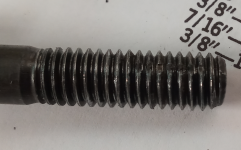Dr.Jass
Pastor of Muppets
The A- and F-body parts were essentially identical through '78, along with a few other body series going back several years. The '79-up F-bodies--and everything else--used the aluminum 2-bolt master with the plastic reservoir, which may have been a rolling change during the '78 model year. My Imperial was born that way. That's what's on my '69 Valiant and what will probably land on the '68 as well when I do the disc swap. I'm a big fan of the 47lb weight difference (OK, it just seems like it's that much). On two of my Challengers, I'll probably go with the nifty aluminum copy of the factory iron 4-bolt unit. Look stock and lose weight = win-win. If anything ever becomes of the junker '74, well, I can do whatever I want there because by rights that car should be crushed.It's got a 4-bolt. Pretty sure it's a Volare part, supplied by Dr. Diff.
"Working on" sounds like solid justification. "Spending money" on the other hand just sounds like gratuitous waste.Now that I can forget about the home water situation for a while I'm back to spending money I mean working on the Duster.
I find it odd that they even offer that plug on a card, but I suppose the RC12YC isn't uncommon for outdoor equipment like lawn tractors, tillers, etc. The part number is just 71 for the boxed (automotve) version, rather than 71-1. It's also strange that it's an RC rather than an RN, but hey--it's their cylinder head.I thought it odd that the Edelbrock recommended plugs (RC12YC) were individually carded and not in a box.
Despite what everyone lists now, the original 360HP plug (as well as the 340) used a heat range of 9 rather than 12 (N9Y, now known as the RN9YC). The 12 will last longer in non-racing use and perform the same other than a tick less resistance to preignition, so it's not a big deal. With the aluminum heads, I would think even a 14 might work OK since the head's going to wick heat out of the plug quickly--perhaps that's why they specified the 12. Most later (emissions-era) small-blocks currently list the RN14YC already, rather than the 12 I suspect was installed originally.


